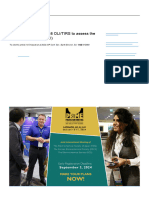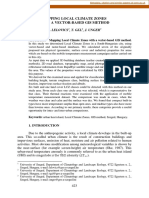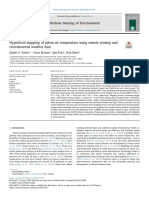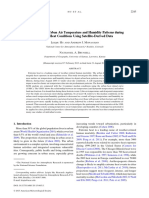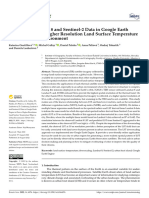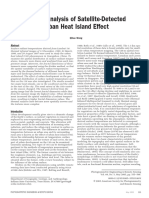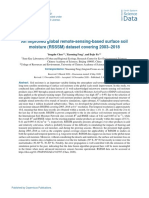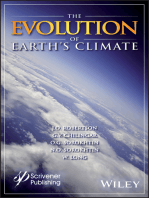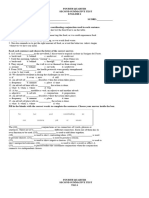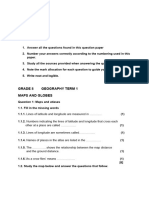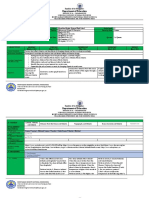Sumit KhandelwalFullPaper
Sumit KhandelwalFullPaper
Uploaded by
Nivaldo PatrícioCopyright:
Available Formats
Sumit KhandelwalFullPaper
Sumit KhandelwalFullPaper
Uploaded by
Nivaldo PatrícioCopyright
Available Formats
Share this document
Did you find this document useful?
Is this content inappropriate?
Copyright:
Available Formats
Sumit KhandelwalFullPaper
Sumit KhandelwalFullPaper
Uploaded by
Nivaldo PatrícioCopyright:
Available Formats
Study of Land Surface Temperature Variations with Distance from Hot Spots for Urban Heat Island Analysis
Khandelwal, Sumit1*, Goyal, Rohit2, Kaul, Nivedita1 and Singhal, Vijai3 ABSTRACT
Vegetation cover has been replaced by impervious areas in most parts of the world in recent years thus giving rise to urban heat island (UHI), in which the temperature of urban areas is several degrees higher than nonurbanized areas surrounding them (Streutkar, 2003; Voogt & Oke, 2003). Land surface temperature (LST) data of years 2005 and 2008 from Aqua/MODIS has been used for determination of maximum temperature areas (hot spots) in different imageries. The analysis has been carried out for three seasons of summer, monsoon and winter seasons. These hot spots from different imageries are compared to find the single hot spot which appears in maximum number of images. Variation in mean LST with distance from this hot spot has been analyzed. Very high correlation coefficient of 0.96-0.98 have been obtained between mean LST and distance from hot spot for different seasons. As the temperature ranges for different seasons of a particular year and for different years of a particular season are normally highly variable, it is essential to bring the different dates LST range to same range, by normalization. Normalized land surface temperature (NLST) has been calculated with values between 0 and 1 for studying the relationship between LST and distance from hot spot. The coefficient of correlation between NLST and distance from hot spots for the years 2005 and 2008 are 0.99 and 0.98 respectively, for polynomial relationship of second order, thus indicating that the UHI effect decreases with increase in distance from hot spots..
1. Introduction
All cities of world have witnessed rapid urbanization, which causes the natural landscape having predominantly vegetation cover and pervious areas, converted into built up and impervious area. This impervious area is largely contributed by use of materials like concrete, bricks, tiles etc for buildings and bitumen etc. for roads and parking lots. The introduction of new surface materials coupled with emission of heat, moisture and pollutants dramatically change radiative, thermal, moisture, roughness and emission properties of the surface and the atmosphere above (Roth, 2002). In addition, urbanization also causes generation of large amount of heat by vehicular traffic, industries and domestic buildings. These modifications cause increase in local air and surface temperatures. Surface and atmospheric modifications due to urbanization generally lead to a modified thermal climate that is warmer than the surrounding non-urbanized areas, particularly at night and this phenomenon is referred as Urban Heat Island, UHI (Voogt and Oke, 2003, Zhangyan et. al., 2006, Hung et. al., 2006). Heat islands can be defined for urban surface (surface urban heat island, SUHI), urban canopy layer (UCL) (layer of urban atmosphere extending from surface to mean building height, CLUHI) and urban boundary
*
Corresponding Author: khandusa@gmail.com Assistant Professor, Malaviya National Institute of Technology, Jaipur 2 Professor, Malaviya National Institute of Technology, Jaipur 3 Sr. Env. Engineer, Rajasthan Pollution Control Board, Jaipur
1
layer (UBL) (layer above UCL that is influenced by the underlying urban surface) (Voogt and Oke, 2003). The study of SUHI has been largely dependent on remote sensing data and land surface temperature (LST) derived from the satellite data is used for that purpose. LST is generally defined as the skin temperature of the surface which refers to land temperature for bare soil, canopy surface temperature for densely vegetated ground and combination of two in case of sparely vegetated ground. Satellite derived LST has been used for a number of UHI studies (Zhangyan et. al.; 2006, Jusuf et. al., 2007; Yuan and Bauer, 2007; Liang and Weng, 2008; Parida et. al., 2008; Cheval and Dumitrescu, 2009; Khandelwal and Goyal, 2010), in which LST dynamics with one or more of surface biophysical properties and urbanization has been studied. The area considered for the studies varied from small blocks (Liang and Weng, 2008) to several cities (Hung et. al., 2006). For example, Zhangyan et al. (2006) studied UHI of Beijing city and found that average urban LST was 4.5 and 9 oC higher than the temperature in suburban and outer suburban areas respectively. Negative correlation was also found between LST and Normalized Difference Vegetation Index (NDVI) in urban area. Yuan and Bauer, 2007, investigated the relationship between the LST, percent impervious area (%ISA) and NDVI and concluded that percent impervious area is an accurate indicator of SUHI effects with strong linear relationship between LST and %ISA for all study seasons. Khandelwal and Goyal (2010) investigated the relationship of LST with NDVI, enhanced vegetation index (EVI) and road density (RD) and found negative polynomial relationship of second order between LST and both the vegetation indices, NDVI and EVI. However the relationship between LST and RD was positive. LST has been computed from different satellite data such as Landsat Thematic Mapper (TM) and Enhanced Thematic Mapper Plus (ETM+) (Yuan and Bauer, 2007, Liang and Weng, 2008), NOAA AVHRR (Streutker, 2002), MODIS (Hung et. al., 2006, Parida et. al., 2008) etc. LST computed from thermal infrared data of Moderate Resolution Imaging Spectroradiometer (MODIS) is freely available and has been used for the present study. In most of the UHI studies discussed above, the central business area is normally the hottest part of the study area, whereas the outer periphery of the study area has the lowest range of temperatures. Major objective of the present research is to study the variations in LST with distance from that part of the study area which consistently encounters maximum temperature range. Such point that remain hot compared to other parts of the study area are referred as hot spot (HS).
2. Methods and Results
2.1 Study area The study area chosen is Jaipur city, the capital of the state of Rajasthan, India. The city is located on a predominantly flat plain and is surrounded by hills on the north, north-east and east sides. Due to the hills, the development of the city has been more along south and west. The part of city closer to the hills is characterized by mostly built-up and paved areas having very less vegetation cover. Rest of the city has a mixture of barren land, low to medium height vegetation and built-up areas in form of buildings, roads, industries etc. The climate of the city is
arid with high temperatures during summers and low temperatures during winter nights. Figure 1 shows the study area for the present study in which MODIS yearly land cover dynamics of 2008 was used to extract the urban boundary of Jaipur city. The Jaipur urban area polygon from land cover dynamics image was automatically converted by using Raster to Polygon conversion tool. A preliminary analysis indicated that a buffer of 12 km is sufficient to include rural belt outside the city area and therefore Buffer tool with 12 km distance outside the urban boundary was used to mark the boundary of study area as shown in fig. 1. The study area has mainly three seasons and the study has been carried out for all three seasons namely summer, monsoon and winter season.
Fig. 1: Study Area 2.2 LST Data Moderate Resolution Imaging Spectroradiometer (MODIS) is a sensor on board Terra and Aqua platforms that provides information about the Earths surface in 36 wavebands covering the visible, near-infrared, shortwave infrared (SWIR) and thermal ranges. Land surface temperature and emissivity product, MYD11A2 of Aqua-MODIS has been used in the present study. MYD11A2 is an eight-day LST product by averaging from two to eight days of the clearsky MYD11A1 daily product of Aqua-MODIS and has 12 Science Data Sets (SDS) layers (Wan, 2007). MODIS is particularly useful for the LST product because of its global coverage, radiometric resolution and dynamic range for a variety of land cover types. It has high calibration accuracy in multiple thermal infrared bands designed for retrievals of SST (Sea Surface Temperature), LST and atmospheric properties (Wan, 1999). A split-window algorithm is used
for calculating LSTs. The day/night LST method retrieves land-surface temperature and band emissivity simultaneously from pairs of daytime and nighttime MODIS data in seven TIR bands. LST composites were downloaded from Land Processes Distributed Active Archive Center (LP DAAC) website using NASA Warehouse Inventory Search Tool (WIST). The downloaded data is in HDF-EOS format and in Sinusoidal Projection System (Land Processes Distributed Active Archive Center, 2010). The data was re-projected from Sinusoidal projection to UTM Zone 43N projection system with WGS84 datum and was reformatted from HDF-EOS to GeoTIFF format. In order to investigate the relationship of LST with hot spots, 8 day LST for day numbers 121-128 (first week of May) representing summer season, day numbers 265-272 (last week of September) representing monsoon season and day numbers 001-008 (first week of January) representing winter season is used. The study has been carried out for all three seasons of 2005 and 2008. Night time LST (here after referred as LST only) has been used for the present study. The raster cell size of MODIS LST product is approximately 926 m. 2.3 Image Processing The downloaded MODIS LST is of a very large area and the raster image corresponding to study area was extracted. Figure 2 shows the LST variations over the study area for all three seasons of 2008. It can be seen from the images that the highest temperature range is concentrated consistently in the central area and the outer boundary of the study area has lowest temperature range.
Fig. 2: LST Image for three different seasons
The LST images of the study area were analyzed for identifying maximum temperature pixels and it was seen that the maximum temperature pixel was variable for different seasons and years. Hot spot has been defined as the pixel which remains in the higher temperature range for maximum images. LST data of both the years of 2005 and 2008 has been used for determination of such hot spot in different imageries. The hot spots from different imageries are compared to find the single hot spot which appears in maximum number of images and the same has been shown in figure 3. After identifying the HS, the distance of all the pixels from hot spot is found and the distance image is also shown in figure 3. The Distance from HS (DHS) varies up to 26.2 km.
Fig. 3: Hot Spot location and Distance from Hot Spot image To investigate the relationship of LST with DHS, a zonal analysis was done to calculate mean value of LST at each 1km increment of DHS. A clear falling trend was found between LST and DHS. Figure 4a and b show the relationship between LST and DHS for all three seasons of year 2005 and 2008 respectively. The polynomial relationship of second order between LST and DHS has been found. Figure also show the equation and coefficient of correlation of the relationship. It can be seen from the figure that the equation of relationship between LST and DHS for a particular season is almost similar for both the years thus indicating a consistent pattern of the relationship for a particular season. The coefficient of correlation is very high and its values are 0.96, 0.98 and 0.98 respectively for summer, monsoon and winter season of year 2005. Corresponding values for the year 2008 are 0.96, 0.96 and 0.98. The difference in equations for different seasons may be due to the different temperature range for different seasons.
Fig. 4: Relationship of LST and distance from HotSpot for different seasons of 2005 & 2008 To further investigate the relationship of LST with DHS for entire year without considering the season, it is important to bring temperature range of different seasons within same range. Therefore a Normalized LST (NLST) index has been defined in equation 1 below, which is the normalized LST of that cell.
NLSTCell
where
LSTCell LSTmax
LSTmin LSTmin
100
(1)
LSTCell = LST of a particular cell LSTmin = Minimum LST for the Study Area of that particular Image LSTmax = Maximum LST for the Study Area of that particular Image The range of NLSTCell is between 0 and 100. Figure 5 shows the relationship between NLST and DHS and the relationship is very strong for the both 2005 and 2008 with R2 value of 0.99 and 0.98 respectively. The curves follow almost the same trend for most of the part and the relationship equation is also almost same thus indicating that the relationship between NLST and DHS is not only independent of season but also it is not dependent on year.
Fig. 5: Relationship of NLST with distance from Hot Spots for different years
3. Conclusions
Relationship between night time LST and distance from hot spots in urban areas has been studied in this paper, where hot spots is defined as a spot where night surface temperatures are consistently higher. It is found that the LST decreases with increase in DHS. Coefficient of correlation for polynomial relationship of second degree is found to vary between 0.96 to 0.98. Relationship is also found between normalized LST and DHS. This relationship is also consistent with R2 values of 0.98 and 0.99 for years 2005 and 2008 respectively.
4. References
1. Streutker, D.R. (2002). A remote sensing study of the urban heat island of Houston, Texas. International Journal of Remote Sensing, 23(13), 2595-2608. 2. Voogt, J.A., & Oke, T.R. (2003). Thermal remote sensing of urban climates. Remote Sensing of the Environment, 86, 370384. 3. Roth, M. (2002). Effects of cities on local climates. In: Proceedings of Workshop of Institute for Global Environment Studies/ Asia-Pacific Network (IGES/APN) Mega-city Project, January 23-25, Kitakyushu, Japan, 13 pp (invited paper). 4. Zhangyan, J., Yunhao, C., & Jing, L. (2006). On urban heat island of Beijing based on Landsat TM data. Geo-spatial Information 9(4), 293-297. 5. Hung, T., Uchihama, D., Ochi, S. & Yasuoka, Y., 2006, Assessment with satellite data of the urban heat island effects in Asian mega cities. International Journal of Applied Earth Observation and Geoinformation, 8, pp. 34-48.
6. Jusuf, S.K., Wong, N.H., Hagen, E., Anggoro, R., & Hong, Y. (2007). The influence of land use on the urban heat island in Singapore, Habitat International 31, 232-242. 7. Yuan, F., & Bauer, M.E. (2007). Comparison of impervious surface area and normalized difference vegetation index as indicators of surface urban heat island effects in Landsat imagery, Remote Sensing of Environment 106, 375-386. 8. Liang, B., & Weng, Q. (2008). Multiscale Analysis of Census-Based Land Surface Temperature Variations and Determinants in Indianapolis, United States. Journal of Urban Planning and Development, 134(3), 129-139. 9. Parida, B.R., Oinam, B., Patel, N.R., Sharma, N., Kandwal, R., & Hazarika, M.K., 2008, Land surface temperature variation in relation to vegetation type using MODIS satellite data in Gujarat state of India. International Journal of Remote Sensing, 29, pp. 4219-4235. 10. Cheval, S., & Dumitrescu, A. (2009). The July urban heat island of Bucharest as derived from MODIS images. Theoretical and Applied Climatology 96, 145-153. 11. Khandelwal, S. & Goyal, R. (2010). Assessment of land surface temperature relationship with MODIS vegetation indices and road density for urban heat island analysis, Submitted to Remote Sensing of Environment for publication. 12. Khandelwal, S. & Goyal, R. (2010). Assessment of land surface temperature-elevation relationship using satellite data of area surrounding Jaipur, India, Submitted to International Journal of Remote Sensing for publication. 13. Land Processes Distributed Active Archive Center, 2010, Land Surface Temperature & Emissivity 8-Day L3 Global 1km, Available online at: https://lpdaac.usgs. gov/ lpdaac /products/modis_products_table/land_surface_temperature_emissivity/8_day_l3_global_1km / myd11a2 (accessed August 2010). 14. Wan, Z., 1999, MODIS Land-Surface Temperature Algorithm Theoretical Basis Document (LST ATBD), Available online at: http://modis.gsfc.nasa.gov/data/atbd/atbd_mod11.pdf (accessed August 2010). 15. Wan, Z., 2007, Collection-5, MODIS Land Surface Temperature Products Users' Guide, (ICESS, University of California, Santa Barbara). Available online at: http://www.icess.ucsb.edu /modis/LstUsrGuide/MODIS_LST_products_Users_guide_C5.pdf (accessed August 2010). ----------------------------------------------------------------------------------------------------------------
Authors Information Paper Reference No.: Title of the paper : Name of the Presenter : Author (s) Affiliation : PN- 367 Study of Land Surface Temperature Variations with Distance from Hot Spots for Urban Heat Island Analysis Sumit Khandelwal Assistant Professor, Department of Civil Engg., Malaviya National Institute of Technology Jaipur, Jaipur, Rajasthan, India-302017 Department of Civil Engg., Malaviya National Institute of Technology Jaipur, JLN Marg, Jaipur, Rajasthan, India302017 khandusa@gmail.com +91-141-2713297 (O), +919829098276 (M) +91-141-2529029
Mailing Address :
Email Address : Telephone number (s) : Fax number (s) : Author(s) Photograph:
Brief Biography (100 words):
Currently pursuing doctoral research from MNIT Jaipur. He received University Gold Medal for B.E. (Civil Engg.) from JNVU Jodhpur. He has published more than 10 papers in International/National journals and conferences. He has undertaken a number of sponsored consultancy projects. He coordinated the National conference HYDRO 2008.
You might also like
- Daily Lesson Plan in Science 6: 4 Quarter Week 3 Day 4Document4 pagesDaily Lesson Plan in Science 6: 4 Quarter Week 3 Day 4Rey Mark Ramos100% (13)
- Land Surface Temperature EstimationDocument10 pagesLand Surface Temperature EstimationJINAL JAINNo ratings yet
- AssignmentDocument15 pagesAssignmentnikhil kumbarNo ratings yet
- 1 - Urban - Heat - Island Zhao Dan ChenDocument14 pages1 - Urban - Heat - Island Zhao Dan ChenTia Dwi IrawandaniNo ratings yet
- A Novel Approach in Identification of UrDocument6 pagesA Novel Approach in Identification of UrAditya BorahNo ratings yet
- Relationship Between Urban Heat Island Phenomenon and Land UseDocument9 pagesRelationship Between Urban Heat Island Phenomenon and Land Usehidayatarif19No ratings yet
- Analysis of Urban Thermal Environment Effect by TIRS and GIS: A Case Study of Zhuhai, GuangdongDocument14 pagesAnalysis of Urban Thermal Environment Effect by TIRS and GIS: A Case Study of Zhuhai, GuangdongMamta AgarwalNo ratings yet
- Karyati 2022 IOP Conf. Ser. Earth Environ. Sci. 1109 012069Document9 pagesKaryati 2022 IOP Conf. Ser. Earth Environ. Sci. 1109 012069taiwobalogun85No ratings yet
- Full TextDocument14 pagesFull Textshuva8No ratings yet
- Urban Land Use Land Cover Changes and Their Effect On Urban Thermal Pattern: Case Study of Nigeria's Federal Capital CityDocument10 pagesUrban Land Use Land Cover Changes and Their Effect On Urban Thermal Pattern: Case Study of Nigeria's Federal Capital CityTemesgen M. MandersoNo ratings yet
- Mapping Local Climate Zones With A Vector-Based Gis Method: E. Lelovics, T. Gál, J. UngerDocument8 pagesMapping Local Climate Zones With A Vector-Based Gis Method: E. Lelovics, T. Gál, J. UngerAline PortoNo ratings yet
- Green Areas and Urban Heat Island in A Tropical CityDocument12 pagesGreen Areas and Urban Heat Island in A Tropical CityRashmi AradhyaNo ratings yet
- LST - Air TempDocument12 pagesLST - Air TempsaraxtwistNo ratings yet
- taloor2021Document11 pagestaloor2021keilee chameng floresNo ratings yet
- 05 - 2016 - Dynamics and Controls of Urban Heat Sink and Island Phenomena in A Desert City - DuplicateDocument15 pages05 - 2016 - Dynamics and Controls of Urban Heat Sink and Island Phenomena in A Desert City - DuplicateJamal HarimudinNo ratings yet
- Venter Rem - Sens.Environ 2020Document14 pagesVenter Rem - Sens.Environ 2020Dana MicuNo ratings yet
- RemoteDocument6 pagesRemoteziggurat20206435No ratings yet
- UrbanheatislandDocument12 pagesUrbanheatislandGouri NairNo ratings yet
- Daytime Urban Heat Islands....Document11 pagesDaytime Urban Heat Islands....lauraNo ratings yet
- The Analysis of The Spatio-Temporal Evolution of The Heat Island Effect and Its Influencing Factors in Huadu District, GuangzhouDocument10 pagesThe Analysis of The Spatio-Temporal Evolution of The Heat Island Effect and Its Influencing Factors in Huadu District, GuangzhouMamta AgarwalNo ratings yet
- Rao 2021Document12 pagesRao 2021DayatNo ratings yet
- Detection of Urban Warming in Recent Temperature Trends in JapanDocument12 pagesDetection of Urban Warming in Recent Temperature Trends in JapanAshraf RamadanNo ratings yet
- Ostrvo 3Document39 pagesOstrvo 3Zev ZekNo ratings yet
- Review Jurnal Geografi Terindeks ScopusDocument11 pagesReview Jurnal Geografi Terindeks ScopusBagus Sukma Pradana Putra05No ratings yet
- Impact of Urbanization On Land Surface Temperature and Surfac 2022 BuildingDocument11 pagesImpact of Urbanization On Land Surface Temperature and Surfac 2022 BuildingCarlos Antonio Niteroi RibeiroNo ratings yet
- Study of Urban Heat Island in Yogyakarta City Using Local Climate Zone ApproachDocument17 pagesStudy of Urban Heat Island in Yogyakarta City Using Local Climate Zone ApproachGlobal Research and Development ServicesNo ratings yet
- A Global Analysis of Land Surface Temper PDFDocument13 pagesA Global Analysis of Land Surface Temper PDFNoureddine BenyaminaNo ratings yet
- A Global Analysis of Land Surface TemperDocument13 pagesA Global Analysis of Land Surface TemperNoureddine BenyaminaNo ratings yet
- BursaDocument8 pagesBursahyrijecaliskanNo ratings yet
- Asaye Reviw Hong KongDocument6 pagesAsaye Reviw Hong KongLens NewNo ratings yet
- Dynamics_of_Land-useLand-cover_and_Land_Surface_TeDocument8 pagesDynamics_of_Land-useLand-cover_and_Land_Surface_TeDr. F. M. NadafNo ratings yet
- MOD16 Global Evapotranspiration DescriptionDocument4 pagesMOD16 Global Evapotranspiration DescriptionrafaresendNo ratings yet
- Analysis of Urban Surface Temperature Using RemoteDocument14 pagesAnalysis of Urban Surface Temperature Using RemoteGramIQNo ratings yet
- The Influence of Land Use On The Urban Heat Island in SingaporeDocument11 pagesThe Influence of Land Use On The Urban Heat Island in SingaporestevekardinaljusufNo ratings yet
- Worldwide Continuous Gap-Filled MODISDocument10 pagesWorldwide Continuous Gap-Filled MODISGeoMathCenterNo ratings yet
- PDF DatastreamDocument15 pagesPDF Datastreamjoseph ayomideNo ratings yet
- Remotesensing 14 04076 v2Document21 pagesRemotesensing 14 04076 v2PankajNo ratings yet
- Remotesensing 04 03596Document23 pagesRemotesensing 04 03596Zeeshan KhanNo ratings yet
- Estimation of Gross Primary Production Using Satellite Data and Gis in Urban Area, DenpasarDocument13 pagesEstimation of Gross Primary Production Using Satellite Data and Gis in Urban Area, DenpasarSubesh JoshiNo ratings yet
- Temprature ProjectDocument16 pagesTemprature Projectjejaw tsehayNo ratings yet
- JETIR2209436Document10 pagesJETIR2209436Ghazal HashmiNo ratings yet
- Fractal Analysis of Satellite-Detected Urban Heat Island EffectDocument12 pagesFractal Analysis of Satellite-Detected Urban Heat Island EffectMuthanna Al-HADEETHINo ratings yet
- Land Surface Temperature Response To Land Use Land Cover Change in Hetauda, NepalDocument15 pagesLand Surface Temperature Response To Land Use Land Cover Change in Hetauda, NepalbikramNo ratings yet
- 1.larasetal JETEAS 34august2012 RelationshipbetweenUrbanHeatIslandPhenomenonandLandUseDocument10 pages1.larasetal JETEAS 34august2012 RelationshipbetweenUrbanHeatIslandPhenomenonandLandUserw12tuguNo ratings yet
- Paper 2015004Document9 pagesPaper 2015004Umar MusaNo ratings yet
- Accepted ManuscriptDocument39 pagesAccepted ManuscriptbadamchipNo ratings yet
- LST & VEGETATION Paper1Document18 pagesLST & VEGETATION Paper1sanu doluiNo ratings yet
- Urban Heat Island and Land Use Cover DynDocument19 pagesUrban Heat Island and Land Use Cover DynalozieuwachituruNo ratings yet
- Two Methods To Mitigate InSAR Based DEMsDocument15 pagesTwo Methods To Mitigate InSAR Based DEMsErsarsit GeaNo ratings yet
- An Improved Global Remote-Sensing-Based Surface Soil Moisture (RSSSM) Dataset Covering 2003-2018Document31 pagesAn Improved Global Remote-Sensing-Based Surface Soil Moisture (RSSSM) Dataset Covering 2003-2018kaikui caiNo ratings yet
- Investigating The Effectiveness of Urban Green Spaces On Mitigating Heat Island Effects in Metropolitan AreasDocument3 pagesInvestigating The Effectiveness of Urban Green Spaces On Mitigating Heat Island Effects in Metropolitan Areastvb7a02f507hktdzm00No ratings yet
- Urban Climate: Richa Sharma, P.K. JoshiDocument16 pagesUrban Climate: Richa Sharma, P.K. JoshiShreeya DeosantNo ratings yet
- MoneimGeocarto PDFDocument17 pagesMoneimGeocarto PDFFaishal AfifNo ratings yet
- Anderson 2024Document25 pagesAnderson 2024regiptoNo ratings yet
- 02 - 2014 - Design of An Urban Monitoring Network Based On Local Climate Zone Mapping and Temperature Pattern Modelling - WoSDocument12 pages02 - 2014 - Design of An Urban Monitoring Network Based On Local Climate Zone Mapping and Temperature Pattern Modelling - WoSJamal HarimudinNo ratings yet
- 02 10.1016@j.uclim.2019.01.005Document18 pages02 10.1016@j.uclim.2019.01.005Jamal HarimudinNo ratings yet
- Soil Moisture Retrieval Quantitatively With Remotely Sensed Data and Its Crucial Factors AnalysisDocument9 pagesSoil Moisture Retrieval Quantitatively With Remotely Sensed Data and Its Crucial Factors Analysissam13scribdNo ratings yet
- Split WindowDocument19 pagesSplit WindowNur RahmaNo ratings yet
- GIS final.editedDocument11 pagesGIS final.editedlewisjun254No ratings yet
- Analysis of Satellite Based Evapotranspiration For Selected Climate Stations of BangladeshDocument6 pagesAnalysis of Satellite Based Evapotranspiration For Selected Climate Stations of BangladeshShovon HalderNo ratings yet
- Rotation and RevolutionDocument31 pagesRotation and Revolutionma antoniette miguelNo ratings yet
- Space PhysicsDocument47 pagesSpace PhysicsZainNo ratings yet
- W6 Learning Area Grade Level Quarter Date I. Lesson Title Ii. Most Essential Learning Competencies (Melcs)Document4 pagesW6 Learning Area Grade Level Quarter Date I. Lesson Title Ii. Most Essential Learning Competencies (Melcs)bry kaligayahanNo ratings yet
- Worksheet - 3: Ntse SSTDocument2 pagesWorksheet - 3: Ntse SSTarunNo ratings yet
- The History of Calendar PDFDocument57 pagesThe History of Calendar PDFPrakashNo ratings yet
- 2ND Summative Fourth QuarterDocument8 pages2ND Summative Fourth QuarterAmor DionisioNo ratings yet
- Time TurningPointsDocument11 pagesTime TurningPointsMohamed Wahid100% (4)
- What Is So Right About The Hindu CalendarDocument9 pagesWhat Is So Right About The Hindu CalendarRakhi PatwaNo ratings yet
- Researchpaper Rainfall Intensity Duration Frequency IDF Models For Makurdi Nigeria2Document12 pagesResearchpaper Rainfall Intensity Duration Frequency IDF Models For Makurdi Nigeria2Opata OpataNo ratings yet
- Climate Profile Myanmar PDFDocument73 pagesClimate Profile Myanmar PDFforuzzNo ratings yet
- Food Engineering - MCQ'sDocument51 pagesFood Engineering - MCQ'sSyntax errorNo ratings yet
- Ch02 RadiatDocument26 pagesCh02 RadiatPa Loma B. SantosNo ratings yet
- BNB HS. 2003 E.C 1st Sem. 2nd Periodic & Model ExamDocument103 pagesBNB HS. 2003 E.C 1st Sem. 2nd Periodic & Model ExamAbex Mehon SewNo ratings yet
- Geography 8 Note Booklet Grade 8Document61 pagesGeography 8 Note Booklet Grade 8leandroapollusNo ratings yet
- GRADE 8 TERM 1 Geography TestDocument4 pagesGRADE 8 TERM 1 Geography TestNkosingiphile MacassaNo ratings yet
- World Geography: Strictly Based On Nda/Na Examination CurriculumDocument58 pagesWorld Geography: Strictly Based On Nda/Na Examination CurriculumTera YarrNo ratings yet
- Page 273 - 281Document11 pagesPage 273 - 28105 陳宗榮 RYAN GERALD CHUANo ratings yet
- A Clear Dating of Dark Ages PDFDocument104 pagesA Clear Dating of Dark Ages PDFgeorgioskchasiotis100% (1)
- Weekly-Learning-Plan Q3 Week25 DIMAPORODocument7 pagesWeekly-Learning-Plan Q3 Week25 DIMAPOROMohammad Javier D. DimaporoNo ratings yet
- Seasons and WeatherDocument3 pagesSeasons and Weatherjaylen gardnerNo ratings yet
- Scotch College Science: The Universe & Our Changing EarthDocument37 pagesScotch College Science: The Universe & Our Changing EarthDavid WangNo ratings yet
- UNIVERSEDocument21 pagesUNIVERSEwaji khan100% (1)
- Iv. Learning Phases and Learning ActivitiesDocument5 pagesIv. Learning Phases and Learning ActivitiesKresta BenignoNo ratings yet
- Chapter 1 Astronomy The Cycles of The SkyDocument30 pagesChapter 1 Astronomy The Cycles of The SkyMa. Lucille AbarracosoNo ratings yet
- 5 e Lesson Plan - The Earth Moon and Seasons - Phy 205Document22 pages5 e Lesson Plan - The Earth Moon and Seasons - Phy 205api-541556922No ratings yet
- Chapter 03 - Solar Energy and Earth-Sun Relationships True / FalseDocument15 pagesChapter 03 - Solar Energy and Earth-Sun Relationships True / FalseAhmoosiNo ratings yet
- Rotation and Revolution: I. Choose The Correct OptionDocument2 pagesRotation and Revolution: I. Choose The Correct OptionKirti MahajanNo ratings yet
- Qy7e7wa6t - Week 37 - Science 7 Approved APGDocument7 pagesQy7e7wa6t - Week 37 - Science 7 Approved APGG- 6 ODL Trisha Mae ClementeNo ratings yet
- NIT Planet Arth: Teacher: Begoña CristellysDocument35 pagesNIT Planet Arth: Teacher: Begoña Cristellysbego docencia100% (1)







